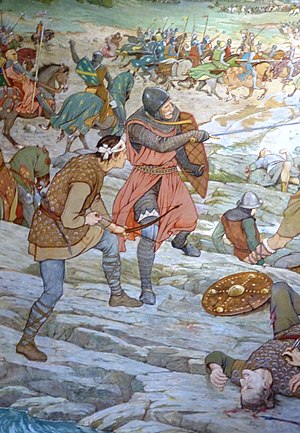Battle of Largs
| Battle of Largs | |||||||
|---|---|---|---|---|---|---|---|
| Part of the Scottish–Norwegian War | |||||||
 Detail from William Hole's mural of the Battle of Largs, in the Scottish National Portrait Gallery |
|||||||
|
|||||||
| Belligerents | |||||||
| Kingdom of Norway | Kingdom of Scotland | ||||||
| Commanders and leaders | |||||||
| Haakon Haakonarson, King of Norway | Alexander of Dundonald, Steward of Scotland | ||||||
| Strength | |||||||
| possibly hundreds | possibly hundreds | ||||||
| Casualties and losses | |||||||
| minimal | minimal | ||||||
The Battle of Largs (2 October 1263) was an indecisive engagement between the kingdoms of Norway and Scotland , on the Firth of Clyde near Largs, Scotland. The conflict formed part of the Norwegian expedition against Scotland in 1263, in which Haakon Haakonarson, King of Norway attempted to reassert Norwegian sovereignty over the western seaboard of Scotland. Since the beginning of the 12th century this region had lain within the Norwegian realm, ruled by magnates who recognised the overlordship of the Kings of Norway. However, in the mid-13th century, two Scottish kings, Alexander II and his son Alexander III, attempted to incorporate the region into their own realm. Following failed attempts to purchase the islands from the Norwegian king, the Scots launched military operations. Haakon responded to the Scottish aggression by leading a massive fleet from Norway, which reached the Hebrides in the summer of 1263. By the end of September, Haakon's fleet occupied the Firth of Clyde, and when negotiations between the kingdoms broke down, he brought the bulk of his fleet to anchor off The Cumbraes.
On the night of 30 September, during a bout of particularly stormy weather, several Norwegian vessels were driven aground on the Ayrshire coast, near the present-day town of Largs. On 2 October, while the Norwegians were salvaging their vessels, the main Scottish army arrived on the scene. Composed of infantry and cavalry, the Scottish force was commanded by Alexander of Dundonald, Steward of Scotland. The Norwegians were gathered in two groups: the larger main force on the beach and a small contingent atop a nearby mound. The advance of the Scots threatened to divide the Norwegian forces, so the contingent upon the mound ran to rejoin their comrades on the beach below. Seeing them running from the mound, the Norwegians on the beach believed they were retreating, and fled back towards the ships. Fierce fighting took place on the beach, and the Scots took up a position on the mound formerly held by the Norwegians. Late in the day, after several hours of skirmishing, the Norwegians were able to recapture the mound. The Scots withdrew from the scene and the Norwegians were able to reboard their ships. They returned the next morning to collect their dead.
...
Wikipedia
